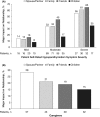Burden of illness in not adequately controlled chronic hypoparathyroidism: Findings from a 13-country patient and caregiver survey
- PMID: 31721256
- PMCID: PMC7027891
- DOI: 10.1111/cen.14128
Burden of illness in not adequately controlled chronic hypoparathyroidism: Findings from a 13-country patient and caregiver survey
Abstract
Objective: To address knowledge gaps regarding burdens associated with not adequately controlled chronic hypoparathyroidism.
Design: Global patient and caregiver survey.
Study populations: Patients with chronic hypoparathyroidism not adequately controlled on conventional therapy and their caregivers.
Measurements: Health-related quality of life (HRQoL) and health status were evaluated using the 36-item Short Form version 2 (SF-36 v2.0) and Five-Level EuroQoL 5 Dimensions (EQ-5D-5L) instruments, respectively. Hypoparathyroidism-associated symptoms were assessed by a disease-specific Hypoparathyroidism Symptom Diary and caregiver burden via the Modified Caregiver Strain Index (MCSI).
Results: Data were obtained from 398 patients and 207 caregivers. Patients' self-rated hypoparathyroidism-related symptom severity was none (3%), mild (32%), moderate (53%) or severe (12%). Per the Hypoparathyroidism Symptom Diary, patients reported moderate, severe or very severe symptoms of physical fatigue (73%), muscle cramps (55%), heaviness in limbs (55%) and tingling (51%) over a 7-day recall period. Impacts (rated 'somewhat' or 'very much') were reported by 84% of patients for ability to exercise, 78% for sleep, 75% for ability to work and 63% for family relationships. Inverse relationships were observed between patient self-rated overall symptom severity and HRQoL and health status assessment scores-the greater the symptom severity, the lower the SF-36 and EQ-5D-5L scores. Caregiver burden increased with patient self-rated symptom severity: none, 1.7 MCSI; mild, 5.4 MCSI; moderate, 9.5 MCSI; and severe, 12.5 MCSI.
Conclusion: Patients with not adequately controlled hypoparathyroidism reported substantial symptoms and impacts. Greater patient symptom severity was associated with decreased patient HRQoL and health status assessments and increased caregiver burden.
Keywords: caregiver; health status; hypoparathyroidism; parathyroid hormone; patient; quality of life; surveys and questionnaires.
© 2019 The Authors. Clinical Endocrinology published by John Wiley & Sons Ltd.
Conflict of interest statement
Shire is a member of the Takeda group of companies. HS and JB have served as advisory board members and speakers for Shire. BLC has served as a consultant for Shire. EG is a volunteer with Hypopara UK, which has received donations from Shire. KM is a current employee and DJ and NB‐E are former employees of Adelphi Real‐World, which was contracted by Shire to conduct this research. KC is an employee of Shire Human Genetic Therapies, Inc, a member of the Takeda group of companies. JG and CM are employees of Shire International GmbH, a member of the Takeda group of companies. HD‐H has no conflicts to report.
Figures



References
-
- Bollerslev J, Rejnmark L, Marcocci C, et al. European Society of Endocrinology clinical guideline: treatment of chronic hypoparathyroidism in adults. Eur J Endocrinol. 2015;173:G1‐G120. - PubMed
-
- Brandi ML, Bilezikian JP, Shoback D, et al. Management of hypoparathyroidism: summary statement and guidelines. J Clin Endocrinol Metab. 2016;101:2273‐2283. - PubMed
-
- Shoback DM, Bilezikian JP, Costa AG, et al. Presentation of hypoparathyroidism: etiologies and clinical features. J Clin Endocrinol Metab. 2016;101:2300‐2312. - PubMed
-
- David K, Moyson C, Vanderschueren D, Decallonne B. Long‐term complications in patients with chronic hypoparathyroidism: a cross‐sectional study. Eur J Endocrinol. 2019;180:71‐78. - PubMed
-
- Hadker N, Egan J, Sanders J, Lagast H, Clarke B. Understanding the burden of illness associated with hypoparathyroidism reported among patients in the PARADOX study. Endocr Pract. 2014;20:671‐679. - PubMed
Publication types
MeSH terms
Substances
LinkOut - more resources
Full Text Sources
Other Literature Sources
Medical

